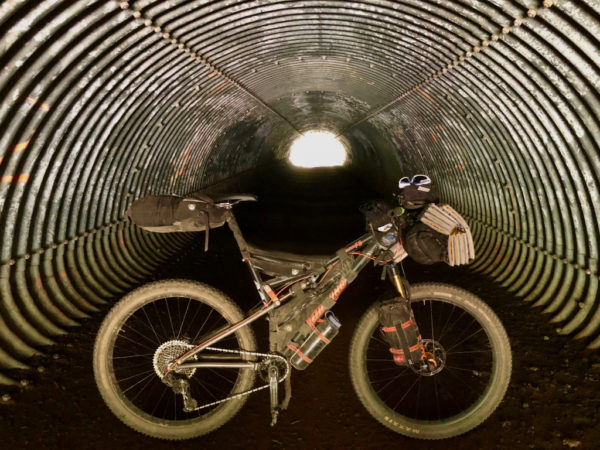
People like to geek out on gear lists. I am one of those people. I always get ideas by seeing how other people roll. To give back to the bike packing community, here is my addition to the gear list cannon.
This is what I used for 18 days and around 800 miles of riding (670 on the OTT plus back to Portland via as much dirt as possible). It is very similar to what I used on the Colorado Trail last year. Both trips I “toured” and didn’t “race” so there is a lot of extra stuff here that I would omit if I was trying to go as fast as possible. The Oregon Timber Trail is a rugged route that is predominantly singletrack (62%) with some two tracks/dirt roads and a bit of pavement. You can find out more about it at oregontimbertrail.org.
Check out my the Fat Camp podcast for my adventure on the Oregon Timber Trail as well as an interview with the route creator. It ended up being kind of long so there are two parts: Part 1 (interview with Gabe and first 300 miles) and Part 2 (Oakridge to the end).
Bike Set-Up:
- Quiring Factory FS frame (100mm rear travel, aluminum front triangle, Ti rear end) with front and rear remote lockout
- Fox 34 factory fork @ 120mm
- I9 hubs, 29er Light Bicycle carbon asymmetric rims @ 34mm inner width, Sapim laser spokes 2x, 2.6″ Rekon EXO front, started with a 2.6 Bontrager XR2 in the rear and switched to a 2.6 Nobby Nic with Apex casing
- SRAM XO Eagle, RaceFace Turbine 180mm cranks, Wolftooth oval camo 32t stainless ring (should have gone with a 30t), XTR Race pedals, SRAM Guide 180/160 brakes and metal pads, Thomson 150mm dropper with Wolftooth remote, Answer Enduro carbon bars, switched to Ergon GE1 Evo Enduro grips in Sisters after my ESI wore out, Fizik Gobi M1 saddle.
Bags:
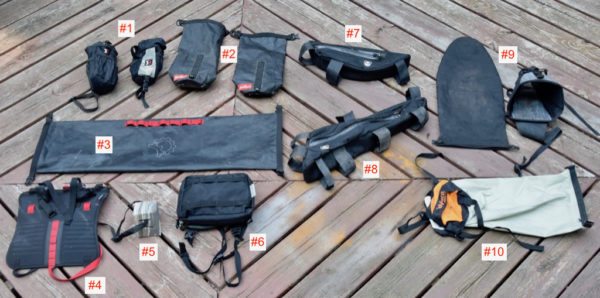
- Two different versions of the Revelate Designs Mountain Feed Bag. The one on the right is an 4 years old and older generation than the right one. The older bag’s bottom pulled out and is hand stitched back together. Also the shock cord pull closure almost sawed through the plastic cord lock and I had to flip it around to wear a different side of the plastic closure mid-way through the trip. The new gen bag is still perfect after 3 years of use. Held my munchies in one bag and the other was electronics (battery, phone, headphones and charge cord for phone).
- Salsa Anything bags that were mounted to King Many Things cages clamped to my Fox 34 with King Universal Support Bolts and held in place by 20″ Voile Straps. I am finding that the Salsa bags wear hole through them over the course of a trip on the Many Things Cages. Setup held most of my food on the trip.
- Revelate Designs Salty Roll held my tent, ground sheet, cook pot, first aid kit, and joy juice. Worked flawlessly.
- Revelate Designs Harness Held the Salty Roll and my sleeping pad
- A block of closed cell foam for fitting kayaks chopped into the right dimensions to space the harness off my headtube. Two strap holes are whittled into it and there is a short section of 1/2″ nylon webbing and ladder lock buckle to hold it all together.
- Oveja Negra Lunchbox Handlebar Bag held lots on misc. stuff I wanted access to while riding: “wallet,” knife, spork, lighter, headset tools, bike lights, headlamp, chamois butter, wide angle lens for phone… I strapped my bedrock sandals under this which was perfect. Was also nice because it gave some redundancy for the stuff strapped to my handlebar
- Rogue Panda Frame Bag #1 mounts on top of the top tube on my Quiring Factory FS. In the main compartment I held food mostly in this but sometimes it had trash, extra water, road beers… This was all purpose, higher volume storage. In the side pocket was suntan lotion and lip balm.
- Rogue Panda Frame Bag #2 mounts inside the main triangle around the shock. In the main compartment I held my tools, spare tube, cup, stove, fuel canister, water pump and tire pump. In the side pocket I held my bike lock and spare spokes.
- Rogue Panda Ripsey seat bag and Xpac dry bag held my soft stuff: Jack ‘R’ Better Shenandoah Quilt, Patagonia ultralight down hoody, spare clothing, Marmot rain jacket, and light wool hat. Used with a Wolftooth Valais.
- Sea to Summit compression sack held my down (or if rain had threatened any clothing I wanted to make sure stayed dry) during the day in my seat bag and was my bear bag at night
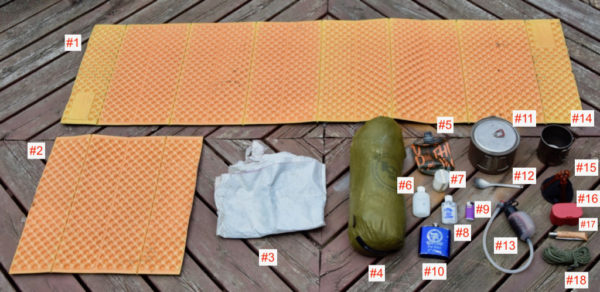
- Therm-a-Rest Z Lite sleeping pad
- Small section of a Z Lite sleeping pad. This serves so many different purposes: extra hip padding when sleeping, a mat to stand on when changing, a butt pad for sitting around, place to set stuff so it isn’t in the dirt/dust… Love this!
- Tyvek ground sheet
- Big Agnes Seedhouse SL2
- 500ml flexible flask that held olive oil
- Nalgene bottle that held roasted sesame oil for asian dishes
- Nalgene container for salt
- Hand sanitizer
- Mini Lighter
- Flask I won at the Yankee Springs Time Trial for the fat bike class in 2013. It held soy sauce. Yeah, I am a food dork if you made it this far in the list and didn’t figure that out.
- MSR Big Titan Tea Ti Kettle is my favorite bit of cookware. It is the same diameter as my seat bag and handlebar roll so it takes up basically no space. This and my stove weigh less than my Ti Jetboil Sol setup and you can actually cook!
- Ti Spork
- MSR Trailshot has worked perfectly on tons of trips and rides now but I do get envious of Sawyers when I have to pump water in the sun.
- Snow Peak 600ml Ti mug
- GSI Outdoors Ultralight Java Drip makes an awesome morning cup of joe, weighs almost nothing and takes up almost no space
- MSR Pocket Rocket
- Opinel Knife NO 8 is light, has a locking blade and is a joy to use.
- Bear bag rope
Not shown was a 2 liter Platy bottle which folded down to almost nothing. This was needed and much appreciated for going over the Winter Ridge. I carried 7+ liters of water for that 50ish mile stretch and was glad to have had it all! I also carried a bottle of bourbon because it was always nice to have a landing drink while making dinner. Also carried a 48oz Nalgene bottle on a King Many Things cage under my downtube.
Food and sleeping are really important to me when “touring” a route like this. I could have gone way more minimal on my shelter and cook system but this setup assured me I would sleep and eat well. I brought granola and ground coffee for breakfast, snacked all day and then would eat a big dinner (1000+ calories) and have a landing drink each night (crystal light and bourbon cocktail!). Maybe at some point I will do a write-up on my dinners because I don’t use dehydrated/freeze dried ready to eat packaged meals and instead use readily available ingredients that don’t require much cooking (generally just pour boiling water over) that are way cheaper and better tasting but just as light and compact for a given amount of calories (but you can tune to your caloric needs).
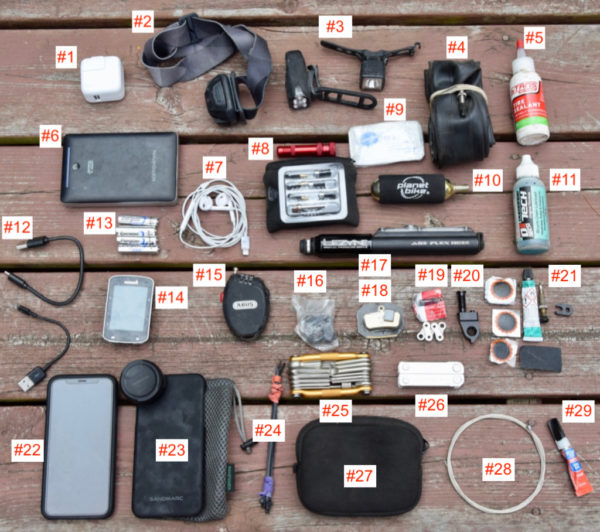
- Apple iPad charger
- Petzl Tikka headlamp
- Small front and rear bike lights (never used them)
- Spare tube
- Sealant
- RAVPower 16750mAh External Battery Pack 4.5A Dual USB Output. I used this in the Colorado Trail and several other bike packing trips. If I keep my phone in airplane mode most of the time I can get about 5 days of charging my phone, Garmin and lights (if just used minimally). If it is really cold, I don’t get nearly as many days of use.
- Earbuds
- Dynaplug Air with regular and mega plugs
- Park tire boot
- 20g CO2
- Dumonde Tech Chain lube
- short USB to lightning and USB to micro usb cables
- Spare AAA batteries for the Spot Tracker
- Garmin Edge 520 had the gpx file downloaded and I used it as my primary navigation while riding
- Abus Combiflex 2502 lock
- Spare cleat and bolts
- Lezyne Digital Pressure Drive. This was a dumb addition and I should have gone with a higher volume pump. I always feel like I run my tires way too hard on a trip like this because I don’t want to get pinch flats of mess about with tire pressure. I was hoping by having a pressure gauge I could lower my pressure with confidence but it still didn’t make me care enough to ever leverage that functionality.
- Spare brake pads
- Spare quick link and extra link of chain
- Spare hanger
- tube patches, spare valve stem and tool to unscrew the valve
- iPhone X. This was where I had all my resources such as Ride with GPS offline maps, route guide, pdf maps, Gaia app with topo maps and gpx file downloaded.
- Wide angle lens for phone
- zip ties
- Crank Brothers M19 multi tool
- Leatherman
- Neoprene bag that I kept all the spare parts and tools in
- Spare derailleur cable
- Super glue
Not shown is a SPOT 3 tracker which I used so family and friends could see where I was at. The AAA lithium batteries never ran out on the trip which was nice but the SPOT is kind of annoying to use (not user friendly) and is fairly expensive because you need to get a yearly subscription. There are way better devices on the market now.
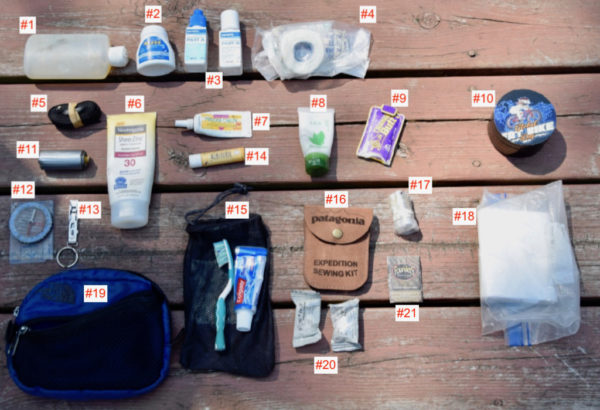
- Dr Bronner Soap
- Aleve
- Aquamira water treatment
- misc bandages
- Spare strap
- Sunscreen
- Neosporin
- Lotion
- Little chamios butter pack I didn’t know I brought
- small tub of chamios butter
- Duct tape on a pencil
- compass
- Nail clipper – The trip was actually long enough to need to cut my nails on this trip!
- Lip balm
- toothbrush and toothpaste
- Patagonia sewing kit
- More AAA batteries (that I didn’t know I brought)
- TP
- Northface bag almost all of this stuff fits in
- Fire starters
- Founders bar matches

- Ibex light weight wool hat. Didn’t really need this
- Outdoor Research Gripper Sensor Gloves
- Civic Wool T-shirt
- Icebreaker Cool-Lite long sleeve hoodie. This is one of my favorite pieces of kit. Super versatile for on the bike or off. It adds just enough warmth to be good across a wide range of conditions and also makes a great sun shirt because of how well it breaths. Thumb holes in the sleeves are the icing on the cake and keep hands a bit warmer but with full finger dexterity.
- Icebreaker (?) lightweight running shirt which has gone on so many adventures I can’t even remember them all. The label is worn off and I bought it so long ago I have no idea what brand this is.
- Light synthetic cycling cap from the Lumberjack 100 race
- Ibex wool leg warmers
- Ketl Minimal Overshort. I pretty much never rode in these because it was too hot but did wear them off bike a bunch. I like everything about these except for the closure system. Why do companies use funky stuff like this short that has a small bit of velcro and a mesh gusset for the fly? The fly on these shorts was constantly opening up.
- Two pairs of Darn Tough Hiker wool socks. Could have gotten by with one pair pretty easily on this trip but it was nice to have a dry pair in reserve. These are a very thick sock which I like because it pads my feet more and reduces discomfort. Obviously they do get toasty in the heat though and do take a lot longer to dry out but on the balance I find the added cushioning to be a bigger factor in overall comfort.
- Assos H.MILLESHORTS_S7. I love these shorts and have used them for all of my big rides. I washed them out each night and never felt the need for a second pair of riding shorts.
- Assos H.RALLYBOXER_S7. Basically this is a lighter, shorter leg version of the other Assos shorts and are dedicated liner shorts for under baggies. I never used these because it was too warm to ever wear baggies during the day. If it had been wet during the ride, a second pair of shorts would have been nice but for the OTT during the summer you can pretty easily get by with a single pair of riding shorts.
- Pack towel that is cut down to half its normal size
- Giro Empire VR90 shoes. This is the same model of shoe I used on the Colorado Trail and for pretty much all my riding/racing (gravel, road and MTB) except for winter riding. They are really stiff so are great on the bike but have good enough knobs to still hike a bike OK. I love the laces because I can adjust fit either via the tension of the laces or modify the lacing pattern to accommodate my feet as they swell, I wear different socks… The only issue I have had with them is that the lugs eventually start to peel off the carbon sole after a bunch of hike-a-bike.
Shown but not numbered was a Giro Fathom helmet. This is basically a road helmet with a small removable visor stuck on it. I like it because it is super airy and light. I knew it was going to be really hot and sunny on the ride so those were top priority over helmets with better coverage.
Not shown, Civic Merino Boxers, Pearl Izumi Divide Full Finger (which had disintegrated by the end and I threw out) and an Osprey Syncro 10 w/ 3L Camelbak bladder.
I think that covers everything! Not sure on the total weight of my gear and bags. I definitely didn’t have a minimal/light setup but I saw people hauling a lot more stuff too so I feel like I was in the ballpark of a comfortable setup that struck a balance (for me) between efficient riding, amenities and precautionary supplies. Hopefully that helps people to get out on a big adventure and feel prepared heading out into the wild country!

Ken,
I’d love to hear more about your food situation!
He digs into that in part 2 of the podcast.